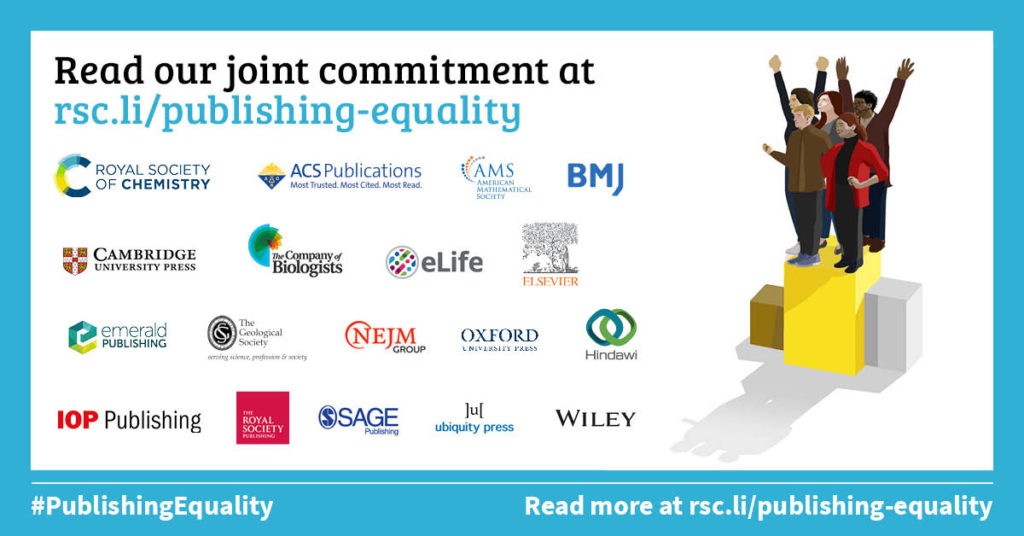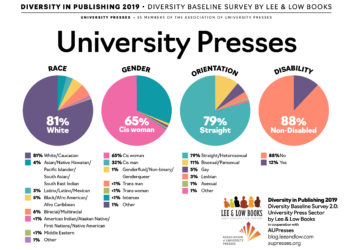While we still have a long way to go before our community is truly diverse, equitable, and inclusive, it’s been great to see a range of DEI initiatives flourish in scholarly communications and publishing over the past few years. Individual organizations and the community at large alike are now taking seriously the challenges we face in working to create a level playing field and making our industry truly welcoming to all. It’s been especially pleasing to see the development of a number of cross-organizational initiatives, both formal and informal, to address these challenges. One of these is the Royal Society of Chemistry’s (RSC’s) Joint Commitment for action on inclusion and diversity in publishing, launched in 2020. Two RSC staff who have been closely involved with this initiative kindly agreed to answer my questions about it. Laura Norton is RSC’s Senior Programme Manager, Inclusion & Diversity, and Nicola Nugent is their Publishing Manager, Quality & Ethics.

Can you tell us a bit about the Royal Society of Chemistry and its approach to diversity, equity, and inclusion — past and present?
Laura: We are a learned society and professional body for the chemical sciences, as well as a publisher of journals, books, and database products. Tackling issues of inequality in the chemical sciences has been a longstanding commitment of ours. We value all members of our community and believe that for the chemical sciences to prosper, they must attract, develop, and retain a diverse range of talented people.
Our approach to Inclusion & Diversity (I&D) is always based on data and evidence which – crucially – is then used to inform practical action to improve science culture. Back in February, 2018 we launched the Diversity landscape of the chemical sciences report, which provided evidence and data to benchmark the current state of I&D in the chemical sciences. In particular, it identified areas where improvement is needed, such as mental health, disability, sexual orientation, ethnicity, and socioeconomic background. However, the most striking result was the lack of gender equality. This led us on to our Breaking the barriers work, uncovering what really prevents women from remaining in, or progressing within, the chemical sciences. This spurred us to take action ourselves, for example our bullying and harassment support service, Grants for Carers, Assistance grants, and the introduction of our annual Inclusion and Diversity Forum.
As publication metrics remain well-recognized markers of scientific success – and have an important impact on career progression – this led us to scrutinize our own publishing processes in terms of gender in our report Is publishing in the chemical sciences gender biased?, which demonstrated that gender differences exist at each step of the publishing process. Many of these appear minor in isolation, yet their combined effect puts women at a significant disadvantage.
Of course, we are also active in many other areas of I&D, for example, our Exploring the workplace for LGBT+ physical scientists research and report, carried out jointly with the Institute of Physics (IOP) and the Royal Astronomical Society (RAS). We are also improving awareness of mental health issues and supporting our community through our Building a better chemistry culture webinar series, and our current work on race and ethnicity and the sense of belonging in the chemical sciences.
In December 2020 we released our new organization-wide I&D strategy to 2025. Our goal is to increase the diversity of people choosing and fulfilling their potential in the chemical sciences for a truly inclusive community, with a particular focus on under-represented groups. We will use data and an evidence-driven approach to ensure fair and equal progression for talented chemical scientists – delivering inclusive publishing is a vital part of that new strategy.
What prompted the RSC to develop the Joint Commitment for action on inclusion and diversity in publishing?
Nicola: In March 2020 we shared a new Framework for action in scientific publishing with our editorial boards, fulfilling commitments made in our earlier report Is publishing in the chemical sciences gender biased?. Our framework maps out the steps we are taking to minimize bias from our editorial and publishing processes across our entire suite of journals. It’s a go-to reference guide that outlines the methods by which we can achieve change, and how this change can be quantified across the publishing process.
Recognizing the framework’s value in addressing issues faced by publishers across multiple disciplines, we decided to be proactive about sharing it. So we convened a virtual workshop with a group of other publishers, to present our framework and discuss ways that we could work together to accelerate progress on I&D in our researcher communities. We found that we had huge areas of common interest, as well as a genuine desire to support positive action in the communities we support. The Joint Commitment for action on inclusion and diversity in publishing was the output of the workshop, and has now been signed by 35 publishers with portfolios in excess of 11,000 journals across many disciplines. By signing up, publishers are demonstrating that they care about the issue – and that they are prepared to make changes that will have real impact on research culture at large.
What does the Joint Commitment cover, and what are its goals?
Laura: Essentially, we want to set new standards to ensure a more inclusive and diverse culture within scholarly publishing. All the organizations that have signed up have pledged to pool resources, expertise, and insight to accelerate progress on inclusion and diversity in publishing. We have committed to work together in four main areas:
- Diversity data collection – which questions should we ask and how to ask them, alongside which systems are most suited to collect this kind of data
- Data analysis to determine baselines and set targets to improve representation
- Sharing and developing resources, policies, language, and standards
- Setting minimum standards on inclusion and diversity for all scholarly publishers to live up to
What progress has the joint commitment delivered so far?
Nicola: Members of the Joint Commitment working group have organised into sub-groups to take forward specific actions under each of the commitments. We’re already seeing the success of this approach as it has opened up a route for positive engagement with organizations such as Clarivate and ORCID. Through our joint efforts we have also now passed on good practice guidelines for author name change policies to COPE and NISO, supporting their efforts to standardize policies and processes for name changes across the scholarly communications ecosystem. The collaboration and willingness to engage that we’re seeing is fantastic.
Laura: From our own perspective, since the publication of our report Is publishing in the chemical sciences gender biased? we’ve seen increases in women authors, editors, and reviewers across our own journal portfolio – driven at least in part by setting targets to improve representation. We’re now looking at other diversity characteristics, as reported in the publishing section of our Diversity Data Report, and we continue to work with the members of the Joint Commitment on robust, and internationally accepted methods of collecting appropriate diversity data.
When, why, and how did you start getting other organizations involved? Do you expect more organizations to join in future?
Nicola: Our Joint Commitment initiative has been inclusive of all publishers right from the start and more are joining all the time. Those signing up are at varying levels of maturity on their progress on I&D but it’s pleasing that, just by their inclusion and willingness, we are moving forward together now as an industry. We’ve also been reaching out to organizations such as ORCID, COPE, C4DISC, Clarivate, and others to make sure we’re involving the right stakeholders and not duplicating effort. In an ideal world we would hope that all publishers either engage with us or join us in sharing good practice, as it is very much a case of strength in numbers to move forward as an industry together, for the benefit of everyone involved.
There are a number of DEI initiatives in scholarly communications (for example, C4DISC, Cell Press’s Inclusion and Diversity Statement, AUP’s ongoing work in this area, etc). What’s different about the Joint commitment?
Nicola: The real strength of the Joint Commitment is its collaborative nature – we have many publishers working together on common goals. We actually have that in common with C4DISC, but the Joint Commitment is focused on inclusivity in our editorial and publishing processes, and supporting increased diversity in our research communities, whereas C4DISC is focused on I&D in the scholarly communication workforce. Of course, the two absolutely must go hand-in-hand and that’s why we already have great lines of communication between the two. I’m sure we’ll continue to have opportunities to work together and support each other’s goals.
Although it’s great to see all these different initiatives, is there a risk of there being too many? Should we as a community be thinking about consolidating our efforts more?
Laura: The Joint Commitment initiative is all about consolidating the efforts of individual publishers. There is a huge amount of great work going on – new initiatives, more inclusive policies, experiments with different peer review models – and signatories to the Joint Commitment have signed up to share their learning and expertise with others, for the benefit of us all. At the end of day, as long as the different initiatives have separate remits and are exchanging knowledge freely, then this can only benefit research culture.
What do you hope will be different in our community in five years as a result of the Joint Commitment?
Nicola: One area that I believe will really benefit our community is diversity data collection. We’re sharing expertise and knowledge to determine which data to collect as well as how and where to collect it. It’s a significant and complex undertaking, but so important. We need accurate data to understand our research communities and to allow us to make much more informed and evidence-based interventions, ultimately leading to a scholarly communications environment that excludes no one.
Discussion
2 Thoughts on "Joint Commitment for Action on Inclusion and Diversity in Publishing: An Interview with Laura Norton and Nicola Nugent of the RSC"
Great interview, and a very exciting initiative!
How would one learn more about becoming a signatory and participating in the joint commitment? I’ve visited the site, but did not see any obvious contact links. Thanks!
Thanks so much for your feedback! Please just drop me a line at nugentn[at]rsc.org and I can provide you with more information about participating.



